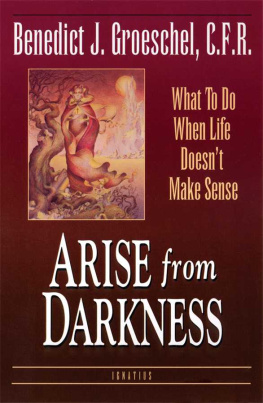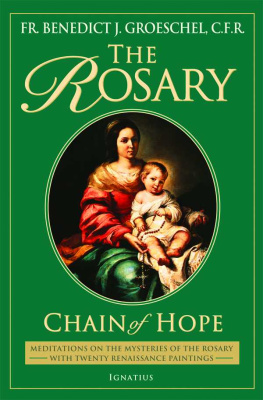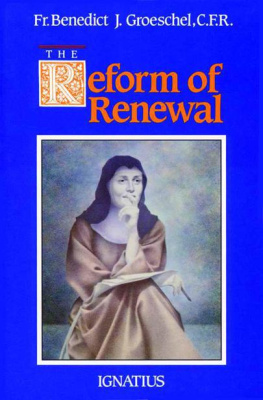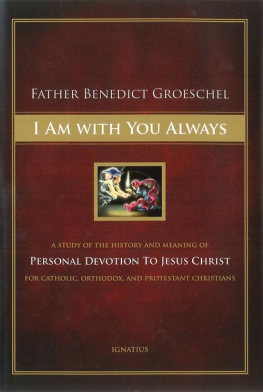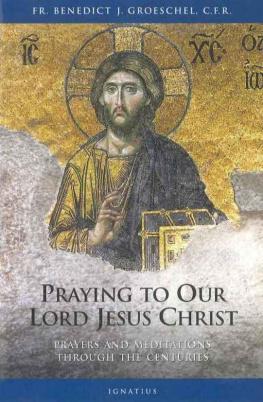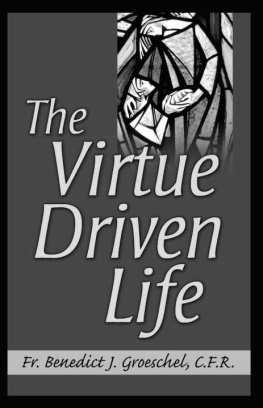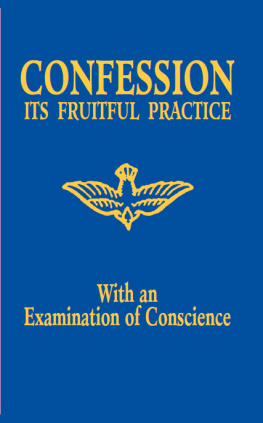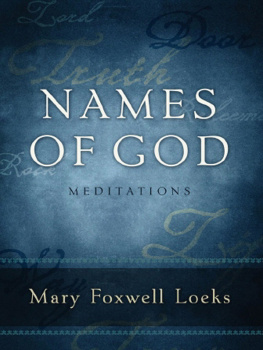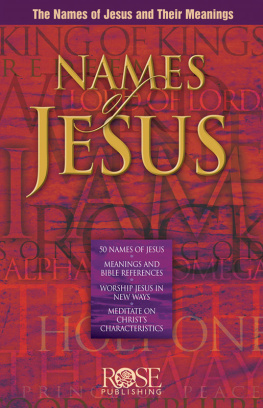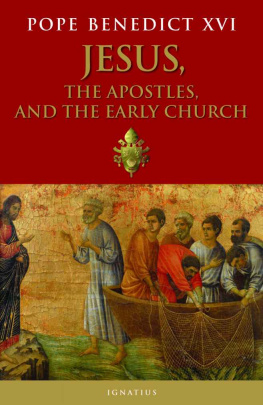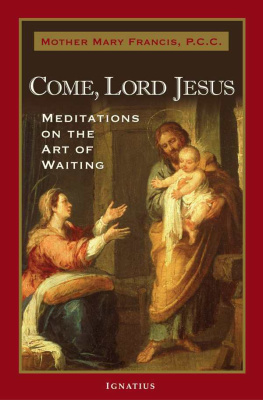Jesus and Mary
JESUS AND MARY
In Praise of Their Glorious Names
by
Father Benedict J. Groeschel, C.F.R.
Our Sunday Visitor Publishing Division
Our Sunday Visitor, Inc.
Huntington, IN 46750
Except where noted, the Scripture citations used in this work are taken from the Second Catholic Edition of the Revised Standard Version of the Bible (RSV), copyright 1965, 1966, and 2006 by the Division of Christian Education of the National Council of the Churches of Christ in the United States of America. Used by permission. All rights reserved.
Where noted, Scripture texts in this work are taken from the New American Bible, revised edition (NAB) 2010, 1991, 1986, 1970 Confraternity of Christian Doctrine, Washington, D.C., and are used by permission of the copyright owner. All rights reserved. No part of the New American Bible may be reproduced in any form without permission in writing from the copyright owner.
Excerpts from the English translation of The Roman Missal 2010, International Commission on English in the Liturgy Corporation (ICEL); excerpts from the English translation of The Liturgy of the Hours 1974, ICEL. All rights reserved.
Every reasonable effort has been made to determine copyright holders of excerpted materials and to secure permissions as needed. If any copyrighted materials have been inadvertently used in this work without proper credit being given in one form or another, please notify Our Sunday Visitor in writing so that future printings of this work may be corrected accordingly.
Copyright 2012 by Father Benedict Groeschel. Published 2012.
17 16 15 14 13 12 1 2 3 4 5 6 7 8 9
All rights reserved. With the exception of short excerpts for critical reviews, no part of this work may be reproduced or transmitted in any form or by any means whatsoever without permission in writing from the publisher. Contact: Our Sunday Visitor Publishing Division, Our Sunday Visitor, Inc., 200 Noll Plaza, Huntington, IN 46750; 1-800-348-2440;
ISBN: 978-1-61278-624-7 (Inventory No. T1321)
eISBN: 978-1-61278-265-2
LCCN: 2012944349
Cover design: Lindsey Riesen
Cover art: The Crosiers
PRINTED IN THE UNITED STATES OF AMERICA
Dedication:
To two of New Yorks dedicated archbishops:
Edward Cardinal Egan
Timothy Cardinal Dolan
and to the memory of a third,
John Cardinal OConnor
ACKNOWLEDGMENTS
One rainy day in October, my good friend Bert Ghezzi of Our Sunday Visitor came from his home in Florida to visit me in New York. He brought with him the idea for this book, which he thought would be a good project for me. I must confess that I was a little resistant at first. I was beginning to think my writing days had come to an end, and (especially on a bleak and rainy day) I didnt feel like committing myself to something new. But Bert is wonderfully persuasive, and in short order he managed to make me very enthusiastic about this project. I thank him for that; this book has been a pleasure to write, and a very prayerful part of my days for several months now. I hope he is pleased with the result.
I would like to thank John Collins, my editor, for all his help.
I also thank a priest friend of mine who was of great assistance in the writing of this book.
CONTENTS
INTRODUCTION
I want to make one thing perfectly clear from the outset: This is a devotional book and certainly not a theological one. I am very pleased to report that there are still decent numbers of Catholics and other Christians whose spiritual lives center on devotion in various forms. They believe very strongly that devotion has deepened and strengthened their relationship with God, with Our Lady, and with the saints. They assert that devotion lends intensity and a joyful vibrancy to their prayer lives. I admit a little proudly that I am among those people. From the earliest days of my childhood, I was immersed in a Catholic culture that was intensely devotional. In those days devotion seemed to be in the very air we breathed. It permeated every aspect of our lives. Christ, Our Lady, and the saints were not just real to us, but very present, and the devotions we pursued kept us constantly aware of this holy and loving presence in our day-to-day lives. Many objects related to devotional practices, such as statues and holy pictures, were common in our homes. Others, such as rosaries, were always in our pockets, and we used them to pray as we walked. Still others, like the Miraculous Medal, hung around our necks every day, the image of Our Lady constantly close to our hearts.
Devotion and devotions, however, fell on rather hard times after the Second Vatican Council. Imbibing perhaps too much of the surrounding cultures excessive rationalism and skepticism, we began to feel a bit ashamed of our devotional practices. After nourishing us for centuries, these practices suddenly seemed old-fashioned and perhaps even Old World. The regular Monday evening devotions to Our Lady of the Miraculous Medal, which formerly had filled whole churches throughout the country, became sparsely attended. Novenas were forgotten. Dramatic images were removed from our churches and replaced with cool, almost abstract representations of Christ and the saints. Tragically, even the Holy Rosary was thought, in some Catholic circles, to be old-fashioned and not worth the effort.
The idea behind all this, I imagine, was that we were supposed to have progressed beyond the need for such aids and gateways into prayer. I believe it was also because certain types of emotions the kinds that may at times appear to be sentimental came to be looked down upon. They were considered childish, inauthentic, perhaps stumbling blocks rather than aids to prayer. The unstated idea was that a mature relationship with God was built on an intellectual foundation. We have seen the same ideas affect the celebration of the Mass. Someone once told me that he thought many priests celebrated the Novus Ordo as if it were a Mass for saints, for those who have no need of any external aid but who can simply plunge into a close relationship with Christ and a profound awareness of the reality of the Eucharist with no preparation. Ordinary people (You know who they are You and I!) have trouble putting their day-to-day lives behind them without the many aids that were once so generously supplied by the Church: the hushed surroundings, so separate from the outside world; the sight and scent of incense slowly wafting upward, as if to heaven; the measured, deliberate, and carefully choreographed gestures of the celebrant; the sound of Gregorian chant, so ethereal that it seemed to be the song of angels. We flesh-and-blood creatures often need such things during Mass to remind us that, for the moment at least, we have separated ourselves from the ordinary world to enter an extraordinary one, a world in which we are in the presence of something special, something unutterably sacred. Without the help of these externals, the very presence of Christ among us can sometimes go unnoticed.
Devotion has been defined in many ways. I think the simplest definition, however, is to say that it is a way of entering into prayer that gives as much emphasis to the heart as it does the mind. Devotion answers the deep needs of our souls. It implies a trust in the emotions, as well as a willingness to use those emotions to deepen our encounters with God in prayer. When we use the term devotion in this way we are saying that we approach God, Our Lady, and the saints not simply with serene thoughts or elegant prayers, but with sighs and groans and perhaps even tears. Devotion is at home with images, and many of the titles of Our Lady and our Divine Savior that are discussed in this book have icons, pictures, or statues intimately associated with them. In many cases, the image came first and the devotion grew later. Who doesnt know what the image of the Sacred Heart looks like? Who doesnt know Our Lady of Perpetual Help? These are devotional images.
Next page

